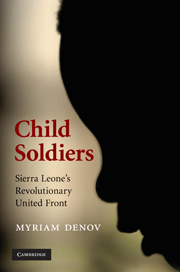Book contents
- Frontmatter
- Contents
- Acknowledgements
- Map
- Introduction: Child soldiers, iconography and the (il)logic of extremes
- 1 Children's involvement in war: The quandary of structure and agency
- 2 Recipe for rebellion: Civil war in Sierra Leone
- 3 Negotiating power: Research on and by child soldiers
- 4 ‘Becoming RUF’: The making of a child soldier
- 5 ‘Being RUF’: Victimization, participation and resistance
- 6 ‘Put dey gon don’: The unmaking of a child soldier
- 7 New battlefields
- References
- Index
7 - New battlefields
Published online by Cambridge University Press: 04 May 2010
- Frontmatter
- Contents
- Acknowledgements
- Map
- Introduction: Child soldiers, iconography and the (il)logic of extremes
- 1 Children's involvement in war: The quandary of structure and agency
- 2 Recipe for rebellion: Civil war in Sierra Leone
- 3 Negotiating power: Research on and by child soldiers
- 4 ‘Becoming RUF’: The making of a child soldier
- 5 ‘Being RUF’: Victimization, participation and resistance
- 6 ‘Put dey gon don’: The unmaking of a child soldier
- 7 New battlefields
- References
- Index
Summary
Sometimes I think that I am a good person.
But then how can I say that I'm a good person after all
the horrible things that I've done?
(Boy)Helping children recover from … their [wartime] experiences
and ensuring their long term reintegration into their communities
remains a considerable challenge.
(United Nations 2007)While Sierra Leone is slowly recovering from the brutal civil war, remnants of the violence remain apparent throughout the country; the sight of amputees and crushing poverty are only a few of the daily reminders of the brutal violence of the past. In addition, less visible markers of violence inevitably pervade the hearts and minds of all those who lived through the war. For the participants in this study, the remnants of violence are powerful and ever-present, although often concealed and spoken of only in highly selective contexts. As this final chapter will illuminate, the narratives gathered from the young people reveal some of the post-war opportunities and challenges for former child soldiers. The chapter addresses some of the new and figurative battlefields that exist at the war's end – for both the child soldiers in this study, as well as the many institutions working on their behalf. The chapter begins by summarizing the link between structure and agency in the process of making and unmaking, underscoring the utility of Giddens' concepts in enabling a greater understanding of the wartime and post-war lives of child soldiers.
- Type
- Chapter
- Information
- Child SoldiersSierra Leone's Revolutionary United Front, pp. 180 - 204Publisher: Cambridge University PressPrint publication year: 2010

